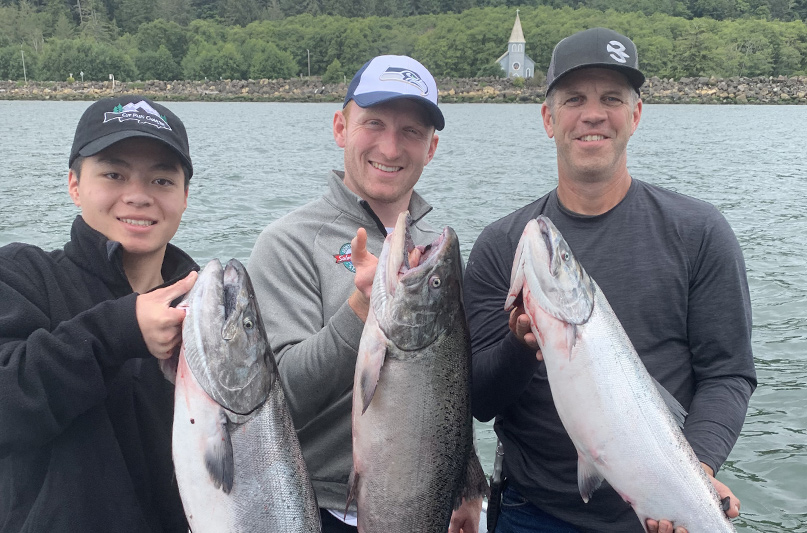The process for setting limits for the 2020-2021 salmon season wrapped up last month, and while summertime opportunities should be blissful, anglers will face some of the most severe cutbacks ever seen in marine winter fisheries. “We value the winter fisheries but I think at the end of the day we wanted to try to preserve as much of the robust summer opportunities as we could,” said Mark Baltzell, the Washington Department of Fish and Wildlife’s (WDFW) Puget Sound Recreational Salmon Manager. “We knew these were tough choices and I don’t want to say we feel good about making these kinds of decisions.”
The closures – that amount to a loss of approximately 24 months of fishing time compared to last year, the most restricted in history – include the eastern Strait of Juan de Fuca around Port Angeles (Marine Catch Area 7) from March 1 to April 15; San Juan Islands (7) and northern Puget Sound at Edmonds-Apple Tree Cove line north to Port Townsend (9) from Oct. 1 to April 30; entire east side of Whidbey Island (8-1 and 8-2) from May 1 to April 30; south-central Puget Sound in Tacoma area (11) from Jan. 1 to April 30; and Hood Canal (12) from Dec. 1 to April 30.
Those still seeking a place to set a line in the winter can head to the western Strait at Sekiu (5) from March 1 to April 30; central Puget Sound in Seattle area (10) from Jan. 1 to March 31; and southern Puget Sound south of the Narrows Bridge (13) is open year-round. Summer and early fall will be the beacon of light for Chinook and Coho.

The northern Puget Sound (9) summer hatchery Chinook fishery opens July 16 to Aug. 15 with a quota of 6,529. The area remains open from Aug. 16 to Sept. 30 for a fishery directed at hatchery Coho. In central Puget Sound (10), the popular Coho-only season opens June 1 to July 15. Hatchery Chinook come into play from July 16 to Aug. 31 with a quota of 4,149. Fishing stays open Sept. 1 to Nov. 16 for Coho and then Chum retention begins on Sept. 16. A small window of opportunity will occur in inner Elliott Bay from Aug. 2 to noon on Aug. 5.
In the San Juan Islands (7) a hatchery Chinook fishery opens July 1-31 with a quota of 1,541. The season could reopen in August if the July quota isn’t achieved. A Coho-only directed season is Aug. 1 to Sept. 30.
South-central Puget Sound (11) should see a rather robust summer hatchery Chinook fishery from July 1 to Sept. 30 with a quota of 4,182. There’s a season directed at Coho on Oct. 1-31. In Strait of Juan de Fuca at Sekiu (5) hatchery Chinook fishing opens July 1 to Aug. 15 (with a catch guideline of 3,974), and for hatchery Coho from Aug. 16 to Sept. 30. The eastern Strait at Port Angeles (6) opens for hatchery Chinook from July 1 to Aug. 15 (release all Chinook east of Ediz Hook) and a catch guideline of 4,768. Hatchery Coho-only fishing opens Aug. 16 to Sept. 30.
The Hood Canal area south of Ayock Point (12) is open July 1 to Sept. 30 for hatchery Chinook. All of Hood Canal opens Oct. 1 to Nov. 30 for Coho and Chum may be retained beginning Oct. 16.
There will also be a variety of terminal fisheries as well as piers open year-round for shore-bound anglers. The Tulalip Bay Terminal Fishery is open for Chinook from June 1 to Sept. 2 (fishing allowed Fridays to noon on Mondays only of each week) and Sept. 7-30 (fishing allowed on weekends only).
On the coast, Neah Bay, La Push, Westport and Ilwaco are open daily for Chinook only from June 20-28. Then Neah Bay, La Push and Ilwaco are daily for Chinook and hatchery Coho from June 29 to Sept. 30; and Westport is open Sundays to Thursdays of each week from June 29 to Sept. 30. All areas could close sooner if catch quotas are achieved.
“Chinook fisheries are likely to be similar to last year (but) Coho forecasts are very low and if accurate, fishing could be challenging this season,” said Wendy Beeghley, the WDFW coastal salmon manager.
The Buoy 10 fishery at the Columbia River mouth is open Aug. 16-27 for Chinook and hatchery Coho and starting Aug. 28 for hatchery Coho only. The catch quota is 16,280 hatchery Coho during August and September.
There are many factors that go into deciding seasons with the main focus being the forecast of hundreds of salmon runs across the state. Further complicating issues are pollution and habitat degradation; fish predation by pinnipeds; the peril and demise of southern resident killer whales; and negative environmental factors like droughts, flooding, and the “Blob” a large mass of warm water in the Pacific Ocean that has taken a toll on coldwater fish and sea critters. A comprehensive list of statewide freshwater salmon fisheries were also decided, and will soon be posted on the WDFW website at
wdfw.wa.gov/fishing.